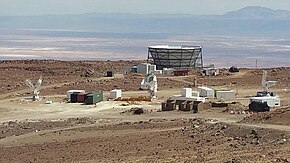 The site of the future Simons Observatory, with the Simons Array, Atacama Cosmology Telescope and POLARBEAR. | |
| Alternative names | Observatorio Simons |
|---|---|
| Location(s) | Atacama Desert |
| Coordinates | 22°57′31″S 67°47′15″W / 22.9586°S 67.7875°W |
| Altitude | 5,200 m (17,100 ft) |
| Wavelength | 27, 39, 93, 145, 225, 280 GHz (1.110, 0.769, 0.322, 0.207, 0.133, 0.107 cm) |
| First light | 2020 |
| Telescope style | cosmic microwave background experiment radio telescope |
| Number of telescopes | 4 |
| Diameter | 6, 0.5 m (19 ft 8 in, 1 ft 8 in) |
| Website | simonsobservatory |
| | |
The Simons Observatory is located in the high Atacama Desert in Northern Chile inside the Chajnator Science Preserve, at an altitude of 5,200 meters (17,000 ft). The Atacama Cosmology Telescope (ACT) and the Simons Array[1] are located nearby and these experiments are currently making observations of the Cosmic Microwave Background (CMB). Their goals are to study how the universe began, what it is made of, and how it evolved to its current state. The Simons Observatory shares many of the same goals but aims to take advantage of advances in technology to make far more precise and diverse measurements. In addition, it is envisaged that many aspects of the Simons Observatory (optical designs, detector technologies and so on) will be pathfinders for the future CMB-S4 array.[2][3][4]
The Simons Observatory has been made possible by a combined $40.1 million grant from the Simons Foundation and a number of participating universities.[5][6][7] The observatory is named after the foundation and its founders: Jim Simons, the hedge fund billionaire and philanthropist who died on May 10, 2024 and his wife, Marilyn, a trained economist. The collaboration is large and multinational with over 250 scientists at over 35 institutions across the world.
The total cost of the observatory is $110 million, with $90 million from the Simons Foundation.[8]
- ^ Suzuki, A.; et al. (2015). "The POLARBEAR-2 and the Simons Array Experiment". Journal of Low Temperature Physics. 184 (3–4): 805–810. arXiv:1512.07299. doi:10.1007/s10909-015-1425-4. S2CID 254695768.
- ^ Inside Science (2017-02-23). "Looking Deeper Into Our Cosmic Past Scientists reveal plans for future experiments to study the faint remnants left behind by the Big Bang". insidescience.org. Retrieved 5 March 2017.
- ^ Symmetry (20 December 2016). "2016 year in particle physics". symmetrymagazine.org. Retrieved 5 March 2017.
- ^ Cartlidge, Edwin (2017). "Huge microwave observatory to search for cosmic inflation". Nature. doi:10.1038/nature.2017.22920.
- ^ Scientific American. "Hunt for Big Bang Gravitational Waves Gets $40-Million Boost". scientificamerican.com. Retrieved 5 March 2017.
- ^ Photonics Media. "Simons Observatory Receives $40M in Funding to Advance Telescopes, Detectors". photonics.com.
- ^ Space Daily. "Simons observatory will investigate the early universe". spacedaily.com. Retrieved 5 March 2017.
- ^ Cite error: The named reference
nytimeswas invoked but never defined (see the help page).
